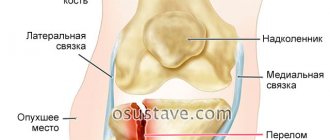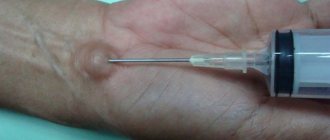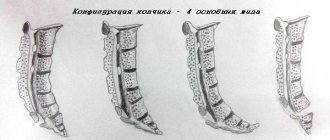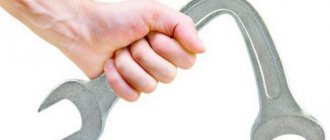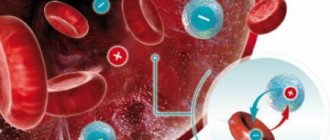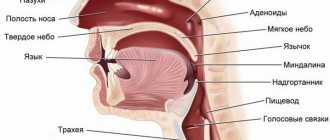A curvature of the nasal septum (deviation, deformation) is a persistent deviation of its shape from the midline, causing difficulty breathing through the nose. With severe deformation, the blood supply to the brain deteriorates, and the normal functioning of the heart and gastrointestinal tract becomes difficult.
If the pathology manifests itself in early childhood, the child develops a characteristic appearance (due to a decrease in oxygen supply to the body): a slightly open mouth, pale skin, asthenic constitution (due to the development of hypoxia and anemia).
It should be taken into account that the nasal septum grows throughout life. Since it consists of several parts that grow at different rates, problems caused by its curvature may become more pronounced with age.
A perfectly straight nasal septum in an adult is extremely rare due to numerous factors and injuries throughout life. More precisely, there are no straight partitions; everyone has some kind of curvature, some kind of ridge of the partition. However, operations are indicated only if respiratory function is impaired. Eg:
- There may be a huge ridge on the septum, but it does not interfere with nasal breathing at all - surgery is not needed.
- If there is a small curvature (or a small but significant ridge) blocking the narrow opening leading to the maxillary sinus, which is fraught with frequent sinusitis, this needs to be corrected.
What is the nasal septum?
In its anterior part it is formed by quadrangular cartilage, and in the rear it is represented by bone tissue (vomer, ethmoid bone and upper jaw). Its deformation can develop in the bone, osteochondral, and cartilaginous sections.
Functions of the nose
- smell – the ability to perceive odors;
- purification of inhaled air - large dust particles are retained by hairs in the nostrils, and small ones are deposited due to electrodynamic attraction to the mucous membrane. All foreign particles with mucus enter the stomach and, like a conveyor belt, are removed from the body;
- warming and humidification of inhaled air - the air is warmed to body temperature, its humidity increases to 100%. Also, when you exhale, the nasal cavity retains moisture and heat from the exhaled air, thus preventing the development of dehydration and hypothermia.
Causes of deviated nasal septum
Deformation of the nasal septum can be congenital and is a hereditary feature; also, a curvature of the nasal septum can be acquired , that is, caused by disturbances in the growth of the skull bones, injuries and neoplasms in the nasal cavity.
Physiological causes of a deviated nasal septum:
- The bones of the skull grow unevenly. A common cause of bending is the rapid growth of the cerebral part of the skull relative to the facial part.
- Inconsistent growth of cartilage, bones and muscles of the nose . The olfactory organ, despite its relatively small size, consists of tissues of different structures, the formation of which can proceed unevenly, resulting in various defects, including a curvature of the nasal septum.
- The nasal septum is obstructed by Jacobson's organ. This pathology is very rare, since in humans the Jacobson's organ is a rudiment, which is a bundle of nerve formations behind the olfactory region. In the case of growth of the organ, with the help of which, for example, reptiles are able to sense air “taste”, the nasal septum does not have enough space for development, as a result of which it becomes curved.
Causes of acquired deviated nasal septum:
- Nose injuries. Even minor blows to the nasal area can lead to displacement of the nasal bones and, as a result, to a deviated septum. And the most severe deformations occur after fractures accompanied by improper fusion of the nasal bones.
- The reasons for the curvature of the nasal septum are the asymmetrical development of the nasal turbinates : a larger one puts pressure on the septum, which leads to deformation.
- polyps and tumors in the nose reach a certain size, they become a serious obstacle to the passage of air through the corresponding nostril. The curvature of the nasal septum in such cases makes it possible to level the nostrils to some extent and ensure normal breathing.
- Inflammatory process in the nasal cavity. The condition of the nasal septum is most strongly affected by diseases that destroy the bones of the skull, for example, syphilis and leprosy (fortunately, rare).
What could be the consequences?
In the photo this is what a deviated nasal septum looks like schematically
Most adults who know firsthand about a crooked nasal septum do not want to undergo surgery to straighten the septum. And all for the sole reason that the symptoms of the pathological process are not pronounced. Before you agree or refuse surgery, you need to understand the consequences of an uneven septum.
As you know, nasal breathing problems are caused by the fact that the brain does not receive enough oxygen. This negatively affects mental activity and ability to work.
With impaired immune defense, the patient does not tolerate exposure to negative environmental factors, which leads to an increased risk of developing an infectious disease.
When a diagnosis confirming an uneven nasal septum has been established, the complications can be completely different. If there are no significant health problems, then special therapy is not worth carrying out. And when the deformation is visually noticeable or there is a chronic process that provides the patient with severe pain and inconvenience, then treatment is prescribed without fail.
On the video, what is dangerous about a deviated nasal septum:
A deviated septum is characterized by complications associated with impaired breathing. They can vary in the degree and depth of impaired breathing. If it becomes impossible for a person to breathe through the nose, while there are no symptoms of a cold, then the reason for this phenomenon lies with an uneven nasal septum. If therapy is not started immediately, air will not be able to penetrate through the respiratory tract at all. This complication is most often the result of a displacement or fracture of the nasal plate.
This article will help you understand how to use and apply chamomile during pregnancy for colds, and how effective it is.
It will also be interesting to know whether raspberries can be taken during pregnancy for a cold, and how such a remedy should be used.
Why brown snot appears from the nose, and how this problem can be dealt with with home remedies, is described in great detail in this article: https://prolor.ru/g/lechenie/korichnevye-sopli-iz-nosa-u-vzroslogo.html
You may also be interested in learning about why adults have snot like water, and what are the main reasons that contribute to this.
An uneven septum in the nose can cause impaired function and pathologies of neighboring organs. Ailments such as otitis media and sinusitis are interrelated diseases with a deviated septum. Deformation of the cartilage allows pathogens to easily penetrate into the auditory tube and middle ear.
An uneven plate also contributes to constant involuntary nervous irritations. They are formed due to constant irritation of the mucous membrane. As a result, cough, astra, migraine, and laryngeal spasm may occur. Lack of oxygen in the brain and blood leads to disruption of gas exchange in the lungs, and this leads to insufficient oxygen supply to organs and tissues. With traumatic damage to the osteochondral tissue of the face of an acute nature, cancer of the nasal septum can occur.
Video showing what a deviated nasal septum affects:
Often, pathology of the nasal plate does not undergo proper treatment, as a result of which the following complications can occur:
- Frequent inflammatory processes . The reason for their development is that air enters the nasal passages with harmful microorganisms. Under normal conditions, the secreted mucus cleanses and moisturizes it. When the septum is deformed, this does not happen, therefore, any infection that occurs can cause acute respiratory infections.
- Allergy of the mucous membrane. This complication is formed for a similar reason. With constant contact with an allergen, irritation of the nasal mucosa occurs, which cannot give a worthy rebuff to foreign microorganisms.
In the photo - allergies of the nasal mucosa
- Frequent pain in the goal. The cause of the pain syndrome is clear. Air supplied from outside does not reach the brain in sufficient quantities due to nasal congestion. Thus, oxygen starvation of the brain tissue occurs, which consequently leads to painful sensations.
- Poor functioning of the cardiac and vascular systems . The reason for this complication also lies in oxygen starvation of the tissues of blood vessels and the heart.
But how to relieve severe nasal congestion, and which medications are the best, is described in great detail in this article.
What folk remedies for nasal congestion without a runny nose appear most often, and what medications will help with this problem, this information will help you understand.
Why does nasal congestion occur in a baby without snot, and what remedies, including home remedies, will help cope with this problem.
But is it possible to use Aqualor when a child has a stuffy nose, and how to do it correctly, is described in great detail in this article.
What is the best effective remedy for nasal congestion for children, and what it is called, is described here in the article.
Deviated nasal septum: symptoms of pathology
The deformation is not always visible, because visually a person can assess the condition of the cartilage tissue between the nostrils, but not the septum itself, located inside the olfactory organ. Experts note that defects in this area of the skull occur in almost all people, but in most cases these are minor deviations that do not cause inconvenience.
Signs of a deviated nasal septum:
- It is difficult to breathe through the nose due to partial blockage of the nasal passage. The problem may affect one or both nostrils, and the degree of discomfort depends on the level of blockage of the nasal passages. This symptomatology is typical, including for fractures, when part of the nasal bone breaks off or is displaced.
- Snoring during sleep and “noisy” breathing. The symptom is typical for children and adults; women with a deviated nasal septum snore no less often than men.
- Chronic runny nose, often accompanied by inflammation of the maxillary sinuses. This condition is due to the fact that due to the curvature of the nose, the contents of the sinuses cannot flow out and stagnate. Mucus coupled with pus is an excellent breeding ground for bacteria, which means the likelihood of a secondary infection increases.
- Damage to the hearing organs. A deviated nasal septum and a source of infection in the maxillary sinuses sometimes causes inflammation of the middle ear. Such extensive inflammation, in turn, leads to increased curvature of the septum.
- Dry mucous membranes , which are constantly in an irritated state, so a person often sneezes.
- A deviated nasal septum is often indicated by polyps ; single or multiple formations appear on the irritated mucous membrane if, despite the obvious deterioration in health, a person does not take measures to correct the septum.
- Obvious curvature of the nasal bridge . Although there is not always a connection between the curvature of the back and the septum: with a slight defect in the nose, the septum can retain its normal shape, but the septum of a straight nose is often curved.
- Changing the timbre of your voice . A crooked septum, coupled with chronic inflammatory diseases of the nose, leads to the fact that a person speaks “through the nose” (nasal).
Possible complications after surgery
- formation of postoperative adhesions, synechiae;
- perforation of the nasal septum;
- allergic reaction to anesthesia (swelling of the larynx, drop in blood pressure, cardiac arrest);
- oculomotor nerve palsy, blindness;
- injury to the cribriform plate, which threatens the leakage of cerebrospinal fluid from the nasal cavity;
- the formation of a hematoma or abscess between the layers of the mucous membrane;
- disturbances in the sense of smell up to its complete absence;
- deterioration of mucosal function (degenerative changes).
In the postoperative period, patients are usually recommended:
- washing with saline solutions (Aqua-Maris, Aqualor) from 2-3 days - to moisturize the mucous membrane;
- avoid heavy physical activity;
- do not fly on airplanes (due to sudden changes in atmospheric pressure);
- for 2-3 months do not be exposed to sudden climate changes, do not get hypothermic or overheated, do not visit baths and saunas.
Diagnosis of a deviated septum in the nose
To detect the deformation, you need to contact an ENT doctor and take an x-ray of the nose in four positions. If necessary, the specialist will prescribe additional studies:
Computed tomography helps to detect spines and ridges located in the posterior parts of the nasal concha, and in addition, identifies concomitant diseases, including chronic sinusitis.
Magnetic resonance imaging - the procedure is prescribed if a tumor (tumor or polyp) is suspected in the nose and middle ear.
Rhinoendoscopy of the posterior sections of the sinuses (a fibroelastic endoscope is used for examination).
Rhinoscopy of the anterior sections of the nasal cavity and deep sections of the septum.
Acoustic rhinometry (measurement of air flows forming in the nose) - this study allows you to determine the degree of nasal congestion.
Possible complications
The most unpleasant complications usually occur if a deviated nasal septum occurs as a result of injury. Because of this, there is a strong mixing of the bones of the skull, which leads to frequent nosebleeds. But even a congenital curvature of the nasal septum without proper treatment can lead to serious health consequences in the future.
It is worth paying attention to the symptoms of a deviated nasal septum in adolescents. Without timely assistance from a doctor, this can provoke chronic inflammation of the paranasal sinuses.
The most common complications of physiological or compensatory forms of curvature can be:
- Decreased immunity;
- Frequent ARVI;
- Sinusitis;
- Sinusitis;
- Frontitis;
- Formation of polyps in the nose;
- Bronchial asthma;
- Chronic rhinitis;
- Dyspnea;
- Chronic diseases of the cardiovascular system.
Sinusitis as a complication of a deviated nasal septum.
Its varieties In children and adolescents, this often leads to a decrease in intellectual abilities, rapid fatigue and the inability to play sports. Chronic “oxygen starvation” of the brain leads to disruption of the normal functioning of the entire body.
What are the types of deviated nasal septum?
There are three degrees of severity of the defect: mild (the septum deviates slightly from the central axis), moderate (the deviation reaches the middle of the sinus) and severe (the septum almost closes with the nasal wall).
Experts distinguish several types of curvatures:
- unilateral comb-like curvature that does not interfere with nasal breathing, which affects the anterior part of the septum;
- a comb-like deformity that disrupts respiratory function, which is clearly expressed and located in the anterior part of the nose;
- unilateral comb-like deformation of the posterior part of the septum;
- comb-like curvatures in both nasal sinuses, in which the septum takes on an s-shape;
- comb-like deformation of the septum of the posterior part of the nose, having the appearance of a “Turkish saber”;
- ridge-like horizontal deformities present in both nostrils;
- multiple curvatures or “crushed” septum.
Attention! A slight curvature of the nasal septum does not affect the breathing process and does not affect a person’s appearance, so they do not need correction. However, in some cases, even a slight deformation creates a “swirl” of air and causes discomfort ; in addition, unpleasant sensations are caused by the spikes and ridges with which the deformed septum “overgrows” - in such cases, the curvature requires treatment.
Treatment
In order to make a correct diagnosis and determine the degree of curvature of the nasal septum, a comprehensive diagnosis will be required. It includes an external examination with assessment of breathing uniformity. To do this, place a piece of cotton wool to each nostril and observe the degree of its deviation during exhalation. If the curvature is complex and not visible from the outside, additional studies may be needed.
A sign of a deviated nasal septum can also be a decreased sense of smell. It can be one-sided or two-sided.
Instrumental research methods include:
- Performing rhinoscopy (most often an anterior rhinoscopy is performed, but sometimes a posterior one may be needed);
- Endoscopic examination of the nasal cavity;
- X-ray of the skull;
- CT scan;
- Magnetic resonance imaging.
If septoplasty is indicated, a general blood test and, if necessary, examination of nasal discharge are additionally performed. The main treatment method for a deviated nasal septum is septoplasty. But like any surgical intervention, it has its contraindications. These include:
- Age over 65 years;
- Children under 15 years of age;
- Mental illnesses;
- Diabetes mellitus of any type;
- Chronic diseases of the cardiovascular system:
- Oncology.
If there are any infectious diseases, then surgery cannot be performed during the period of exacerbation. In this case, only conservative, that is, drug treatment is indicated.
By medication
Treatment of a deviated nasal septum without surgery using medication includes:
- Intranasal glucocorticosteroids (eliminate chronic rhinitis, relieve nasal breathing);
- Vasoconstrictor drops or sprays;
- Cromones (used to treat allergic rhinitis);
- Moisturizing sprays based on sea water;
- Sprays with mucolyte (help quickly remove mucus from the nose).
This therapy is most often indicated for children under 15 years of age, which helps restore impaired breathing until surgery is performed.
Folk remedies
If surgical treatment is not possible, folk remedies can be tried in addition to drug therapy. However, alternative methods cannot be considered as a complete replacement for drug treatment. Before using any home remedies, please consult your doctor first.
Traditional methods of treatment cannot radically change the shape of the nose, but they will help reduce unpleasant consequences.
Alternative treatments include:
- Light massage of the wings of the nose;
- External lotions;
- Breathing exercises.
Ingoda helps with the use of such ultrasonic devices as “Vitafon” or “Atmos Antirunny Nose”. Of course, their use cannot affect the cause, that is, deformation of the nasal septum. This only helps to temporarily relieve unpleasant sensations, such as nasal congestion.
Deviated nasal septum: treatment of pathology
Deformation of the septum can be corrected surgically, and the operation is mainly performed to restore the functions of the nose (the aesthetic side of the issue is important, but is not an end in itself). The operation to correct (reconstruct) the septum is called rhinoseptoplasty ; it is prescribed to patients with severe curvature and who have difficulty breathing through their nose.
Thirty years ago, the treatment for a deviated nasal septum consisted of its removal, but today gentle techniques have been developed that make it possible to remove only the ridges that interfere with breathing . No special preparation is required for the operation, but it is worth treating diseased teeth, as they are a source of infection (by the way, the tonsils can also be a source of infection, they also need to be checked). Rhinoseptoplasty is often accompanied by significant blood loss, so women should undergo surgery taking into account the menstrual cycle (preferably two weeks after the next menstruation).
Contraindications to surgical correction of the nasal septum are common for surgical interventions, although there are also specific “taboos”, for example , the operation is not performed immediately after a respiratory illness (at least a month must pass after recovery), in addition, septum correction should not be performed during the flowering of grasses . The last limitation is associated with the possibility of exacerbation of allergic rhinitis, which can worsen the patient’s condition in the postoperative period.
A deviated septum is usually operated on under general anesthesia, but sometimes local anesthesia (injection of novocaine or lidocaine) is sufficient. If the deformity is not a consequence of injury, then endoscopic septoplasty is most often used, which avoids bleeding and, as a consequence, the formation of hematomas; In such cases, the operation is performed using a fiber endoscope.
An interesting technique used to correct curvature is laser septochondrocorrection, based on the ability of cartilage to change shape under the influence of laser radiation . This type of intervention is performed on an outpatient basis; its advantages: minimal blood loss and low level of tissue damage, rapid patient recovery and low risk of secondary infection due to the antiseptic properties of laser radiation. Unfortunately, this innovative technique is not suitable for cases where bone tissue is involved in the pathological process.
The resection-reimplantation technique, which involves removing deformed areas, is often very effective for “straightening” the septum . The cartilage fragments are given the desired shape by passing them through a special device (flattener), and then returned back, implanted under the mucous membrane. This unusual technique is good because there are no problems with tissue engraftment, which means quick restoration of the septum.
Classical submucosal resection involves removal of a deformed portion of the septum and is rarely used today. The fact is that after this operation the septum vibrates when breathing, and it does not eliminate nasal congestion. In addition, after classical resection of the deformed area, there is a high risk of the dorsum sinking (the nose takes on a saddle shape).
Surgical treatment for a deviated septum does not leave any scars on the face, as the incisions are made through the nostrils . During the operation, the doctor separates the mucous membrane from the nasal septum, corrects the defect and applies stitches. During the day, tampons (turundas) moistened with a hemostatic drug remain in the patient’s nose. Also, silicone splints are often installed in the nose to help the restored septum maintain the required shape. If the patient has asymmetry of the ethmoid bone and turbinates, then these defects are also corrected during surgery to correct the curvature of the nasal septum.
Negative consequences of surgical treatment of a deviated nasal septum:
- hemorrhages (hematomas) under the mucous membrane;
- profuse nosebleeds;
- purulent sinusitis;
- inflammation and formation of abscesses in the surgical area;
- formation of a hole (perforation) in the nasal septum;
- deformation (most often sinking of the back) of the nose.
Rhinoseptoplasty technique
The operation is performed under general endotracheal anesthesia (insertion of an endotracheal tube into the trachea and supply of anesthetic gas) and local anesthesia (injection of local anesthetics - novocaine, lidocaine). There are several types of rhinoseptoplasty:
Endoscopic septoplasty
This operation is indicated for patients with non-traumatic curvatures. The use of a fiber endoscope allows you to prevent complications such as the development of bleeding and the formation of hematomas.
Laser septochondrocorrection
The operation is bloodless and safe for patients. It is based on the fact that cartilage can change its shape under the influence of laser radiation. The operation is performed on an outpatient basis and does not require hospitalization in the ENT department. Its advantages:
- minimal blood loss
- minimal tissue trauma
- rehabilitation and postoperative period are much milder
- laser has antiseptic properties
The disadvantage of the laser is that it is not able to correct all deformations of the nasal septum, especially the bone part.
Resection-reimplantation technique
The curved sections of cartilage and bone are cut out, then straightened using a special flattener and implanted back under the mucosa. The advantage of the operation is that the patient’s own tissue usually heals well and restores the septum, preventing the development of perforation.
Classic submucosal resection according to Killian
The operation is quite outdated; its essence is to remove the curved osteochondral layer of the septum. This resection has many side effects:
- the septum becomes mobile and can vibrate when breathing;
- the nose may sag, taking on a saddle shape;
- After surgery, patients’ complaints often do not disappear (nasal congestion, mucous discharge);
- the septum may be perforated.
Deviated nasal septum in children
The nasal septum is shifted from the center in approximately 80% of children , and in more than half of the cases this is a congenital defect associated with the peculiarities of the formation of the nose in the prenatal period. In addition, the nose is often damaged during childbirth, since the bones and cartilage of the organ are very soft, even a small impact is enough to change their shape, and most often it is the septum in the nose that is bent. And in later life, a child can injure the cartilage that divides the nasal cavity into two parts - this usually happens during games and sports .
A deviated nasal septum is not always clearly noticeable in children, but parents should be wary of nasal discharge and breathing problems, for example, the fact that the child breathes through the mouth, as well as frequent attacks of allergies. Observations show that the deformation of the nasal septum begins to cause obvious discomfort to the child during the change of milk teeth to permanent ones, which is associated with intensive growth of the jaw bones . But in children under three years of age, deviated septum is difficult to diagnose; with a high degree of probability this can be done after the child turns three or four years old.
A deviated nasal septum in children is dangerous because, due to the defect, the tissues of the nose are formed unevenly, and one side of the organ becomes wider than the other . Such asymmetry not only disrupts the proportions of the face, but also changes the characteristics of the air flow through the nose into the lungs. Nature has provided a person with two equal nasal passages in order to ensure a uniform supply of heated, filtered and humidified air, and due to the curvature of the dividing cartilage, the air is retained for some time in the nasal cavity and nasopharynx, which leads to drying out of the mucous membranes of these areas. Constant irritation provokes swelling of the mucous membranes, which in turn causes a narrowing of the nasal passages, as well as inflammation of the maxillary sinuses and even the Eustachian tube located in the middle ear.
In children, the nasal septum is curved either in one or both directions (S-curvature); the pathology rarely affects bone tissue; cartilage is more often affected. As a result, the sense of smell is impaired, recurrent sinusitis (chronic runny nose) develops, the children complain of headaches and suffer from frequent nosebleeds.
A deviated nasal septum is dangerous because without proper treatment it can lead to the formation of a polyp and chronic sinusitis. At the same time, it is impossible to use effective surgical treatment until a certain age and you have to be content with drug therapy, that is, use medicinal compositions whose action is aimed at relieving tissue swelling and expanding the nasal passages . For these purposes, salt rinses, steroids and antihistamines are used.
Main symptoms, complaints
Modern statistics show: 90% of adults are diagnosed with this pathology during examination. However, not everyone has complaints about it. In many cases, it is asymptomatic. The main complaints of the disease include:
Rhinitis and sinusitis
With this pathology, the patient experiences sinusitis (frontitis, ethmoiditis, sinusitis, sphenoiditis) much more often when the infection penetrates into the paranasal sinuses than in a person without such a defect. And also in 3% of cases allergic rhinosinusopathy develops, in 15% vasomotor rhinitis.
According to some authors, the majority of patients (with a deformed nasal septum requiring surgery) have a concomitant pathology, namely chronic sinusitis (in 47% of cases), which is accompanied by:
- nasal congestion;
- discharge of a mucous or mucopurulent nature;
- watery eyes and sneezing;
- nasal voice.
Snoring, sleep apnea phenomenon
- Often, patients with this pathology complain of snoring (according to statistics, men are 2 times more likely than women).
- However, snoring is not only a disturbance to the sleep of those around you. Such patients experience short-term episodes of breathing apnea during sleep (see causes of snoring and treatment).
- Patients often complain of daytime sleepiness, headaches, poor performance at school and at work, and increased blood pressure (due to impaired blood supply to the heart and brain).
Difficulty in nasal breathing
This symptom can be expressed to varying degrees, from a slight disturbance of nasal breathing to its complete absence, when a person is forced to breathe through the mouth. There are frequent cases when nasal breathing is difficult not due to the curvature of the nasal septum, but due to the presence of hypertrophy of the nasal turbinates. In this case, the tissue of the lower nasal conchae grows, and as a result, the lumen narrows, and weak nasal breathing occurs. A person turns to an ENT specialist, and he diagnoses a crooked nasal septum (since it is curved in most people). After the operation, my nose still cannot breathe. In such cases, excess tissue should be removed with a laser.
Other symptoms
- Decreased sense of smell - the ability to perceive odors is impaired, up to a complete absence of smell.
- Nosebleeds - the deformity causes thinning of the mucous membrane, especially in the lower part where the choroid plexuses are concentrated. As a result, any injury, even simple nose picking, can cause heavy bleeding.
- Frequent sore throats and bronchopulmonary diseases - when breathing through the mouth, the air is not cleared of dust and germs, which allows them to enter the lungs and provoke frequent acute respiratory viral infections, as well as bronchial asthma.
- Dryness of the nasal mucosa - the reason for the appearance of dryness in the nose is as follows: with a strong curvature of the nasal septum, the mucous membranes can come into contact with each other, disrupting the functioning of the cilia and cells that secrete mucus.
- Periodic headaches are reflexive in nature and are associated with irritation of the mucous membrane.
- Congestion and noise in the ears, hearing loss - due to the spread of the inflammatory process to the middle ear through the Eustachian tube. In advanced conditions, hearing loss may develop.
- Dry mouth - if a person is forced to breathe through the mouth (with severe deformation), moisture from the mucous membrane evaporates, and dry mouth appears.
- Cosmetic defects - in children, due to pathology, an adenoid type of face develops - a slightly open mouth, malocclusion, nasal voice. Cosmetic defects of the nose are also possible after injuries and bruises.
The main thing about the curvature of the nasal septum
| Question | Answer |
| Causes of a deviated nasal septum | birth defect, birth or other trauma, uneven growth of nasal tissue, polyps and neoplasms in the nasal passages. |
| Symptoms of a deviated nasal septum | nasal congestion, difficulty breathing, snoring, chronic runny nose, dry mucous membranes. |
| Treatment of a deviated septum in the nose | only surgical (rhinoseptoplasty). |
| Non-surgical methods for treating nasal septum | There are no such techniques, since it is impossible to straighten the septum without surgery. Drops, sprays and nasal rinses only weaken the symptoms of the pathology. |
| Prevention: deviated nasal septum can be avoided | if you protect your nose from injury. |
| Contact doctors | otolaryngologist (ENT), plastic surgeon. |
| How to correct a deviated nasal septum for free (under compulsory medical insurance policy) | deviated nasal septum is treated free of charge in public hospitals; the operation is performed solely for medical reasons (for example, the patient has developed chronic sinusitis, bronchitis or otitis media). |
Definition of disease
A deviated nasal septum is a hereditary (congenital) or acquired defect of the cartilaginous membrane dividing the nasal cavity. In this case, curvature of the bone tissue and cartilaginous septum often occurs, resulting in a C- or S-shape. This leads to disruption of the normal functions of the nasal cavity, namely humidification, warming and purification of inhaled air.
The nasal septum in a newborn is most often perfectly straight and even. The deformation process usually begins during the period of active growth.
With a serious curvature of the cartilaginous nasal septum, the normal distribution of air flows in the nasal cavity is disrupted. Another unpleasant consequence is a decrease in the sense of smell due to a decrease in receptor sensitivity. Deviation of the nasal septum is divided into left-sided, right-sided, and somewhat less commonly, affecting both sides. Sometimes there is a so-called spike-shaped curvature, which only partially affects the cartilage tissue.
Deviated nasal septum before and after surgery photos
Prevention
There are no guaranteed ways to prevent a deviated nasal septum, since this is often a physiological feature. But you can reduce the risk of compensatory or traumatic curvature. To do this, just follow simple recommendations:
- Treat colds or flu in children promptly. This will help prevent the appearance of adenoids in children.
- Avoid nose injuries.
- See a doctor promptly if you have any warning symptoms.
It is especially important to seek help from a specialist in a timely manner if such a problem occurs in a child. This will help prevent serious health problems in the future.
Treatment of ethmoiditis
Treatment of colds at home is described in this article.
Symptoms and treatment of false croup in children //drlor.online/zabolevaniya/gortani-glotki-bronxov/lozhnyj-krup/u-detej-simptomy-prichiny-i-lechenie.html
Treatment without surgery
Of course, the largest number of patients with this pathology do not immediately consult a doctor, but only when complaints accumulate and the process is far advanced. Then surgery is inevitable.
Only if the deformation has occurred to an insignificant extent and does not cause significant ventilation disturbances, you can “not go under the knife.” It is in such cases that there is a chance to straighten the nose without surgery.
How to straighten the nasal septum using conservative methods?
If a curvature of the nose occurs after an injury, then within a few hours or even a day you can “put” the septum in place using special elevators. This is done without any cuts.
The second way to correct a crooked nose without surgery is laser septochondrocorrection . It is currently applicable only in the case of anterior deformities, or in the case when a significant part of them is cartilage.
This is possible because the laser is capable of bloodlessly vaporizing cartilage defects, but it is not powerful enough to do the same with bone tissue. In a sense, this type of treatment can be called a “bloodless” and “non-contact” operation. For most patients this is quite acceptable.
The second name for this operation is laser thermoplasty. It is used if the elastic cartilage can be returned to its normal position. For example, simply by pressing on it with your finger. If you release the finger, the elastic cartilage will return back.
To fix it and give it rigidity, it is heated with a laser.
The operation itself on the nasal septum is carried out within a matter of minutes, and for anesthesia it is enough to drip lidocaine spray so that it does not hurt. After the operation, a tampon is inserted into the patient’s nose to fix the cartilage and sent home. The next day the tampon is removed. That's all.
But in order to straighten the nose without surgery, you need to pay a large amount of money. Thus, the average cost of this type of treatment in Moscow averaged 55,000 rubles.
Therefore, everyone can choose treatment methods. The main thing is that it is carried out if there are indications for it.
to the content?
Causes and types of nasal septum deformities
There are several types of causes for curvature of the nasal plate:
- ● physical;
- ● traumatic;
- ● compensatory.
Physical curvature occurs during the development of the body and is associated with uneven tissue formation. One part of the septum may develop more slowly than the other. This leads to its curvature or the formation of ridges and spines.
Traumatic deformity is more common in men, as they are more susceptible to external damage to the nose, especially in adolescence. The septum can also be injured at birth, when during the birth process the child receives a dislocation of the cartilage of the nasal septum. Even minor damage in the future can lead to deformation.
It happens that curvature occurs under external pressure. For example, as a result of tumors and polyps, or when hypertrophy of one of the nasal conchas occurs. Breathing, in this case, is greatly impaired, and the septum moves to the side. This curvature is called compensatory.
Rehabilitation after correction of the nasal septum
For 7-12 days after septoplasty, the patient stays in the clinic so that doctors can monitor his condition. For the first week, turundas are placed in the nose, which are changed regularly. This can be somewhat difficult because you have to breathe through your mouth. At the same time, the patient undergoes antibacterial rehabilitation (he is prescribed a course of drugs to prevent infectious complications). It is also often necessary to prescribe analgesics because the nose can be very painful. When the turundas are finally removed and the doctor concludes that there are no complications, the patient is discharged. The swelling may last for a couple of weeks, so for now you have to breathe through your mouth. Gradually, breathing returns to normal, the pain goes away, and the person returns to normal life again. For a month after septoplasty, it is recommended to avoid physical overload and severe temperature changes.
Only a doctor can determine the need for surgical treatment of a deviated nasal septum. In most cases, it is concluded that surgery is inevitable, because complications due to nasal deformity can bring much more illness and suffering to the patient.
Where can I have the operation and how much does it cost?
Most large hospitals in public and private clinics with ENT departments perform this operation.
The free way to a straight nasal septum is through an ENT doctor at the regional clinic to which you belong. The doctor will issue a referral to the hospital, where you will be put on a waiting list and after the necessary examinations and after a certain period of time, you will undergo septoplasty. If you go this route, there are two disadvantages - time and the qualifications of the operating doctor, which may or may not be the highest. Fortunately, there are not so many very young doctors, and novice surgeons always work under the guidance of their more experienced colleagues.
The cost of a classic operation, including hospital stay, ranges from 20,000-100,000 rubles. It is worth considering here that the price is often inflated, citing the use of laser and wave scalpels, however, given the small incisions inside the nasal passages, the use of such expensive equipment looks doubtful. Laser septoplasty is much more expensive and prices range from 40,000-30,0000 rubles.
Features of pathology in children
A deviated nasal septum in young children is diagnosed much less frequently than in adults. Despite this, this feature of the body can cause difficulty breathing in a child, oxygen starvation, nasal sound and cause developmental delays.
The causes of pathology in childhood include:
- trauma during childbirth;
- blow to the nose;
- discrepancy between the growth of bone and cartilage tissue in adolescence.
Outwardly, the changes may not be noticeable, but upon examination, an experienced doctor may notice that one nasal sinus is narrowed and the air in it does not circulate well. A child may often suffer from a runny nose and otitis media.
Due to the fact that the child’s nasal septum is still developing, surgery is not prescribed until the age of 16, but conservative therapy is used. The goal of medication treatment is to relieve swelling and restore breathing.
Types of growths in the nose
There are several types of growths in the nose:
- Cone
- Hematoma of the nasal septum
- Polyps
- White seals
- Basalioma
- Thorn
- Cancer
Cone
A bump on the septum is a small lump that can cause pain, difficulty breathing, and just plain discomfort. This disease is quite common and occurs in both men and women. A lump is formed due to the influence of the following factors on the body:
- Weakening of the immune status.
- Chronic pathological processes in the nasal cavity.
- Septal defects.
- Violation of the integrity of the mucous membrane.
- Presence of adenoids.
- Poor nasal hygiene.
In addition to the listed risk factors, some diseases can contribute to the appearance of bumps on the septum:
- A furuncle is a purulent pathology that primarily affects the hair follicles. Foci of localization can be in any part of the nasal mucosa. It is characterized by the appearance of a compaction that is painful to the touch. When opening a purulent formation inside the nose, complications are possible, including sepsis.
- Polyps are benign neoplasms that arise due to frequent colds, due to changes in the structures of the nasal mucosa. Mainly localized on the septum.
- Malignant neoplasm can also cause a bump on the nasal septum. Characterized by difficulty breathing, pain, bleeding, headaches.
- Glioma is a benign tumor that can be congenital. Gradually increases in size, causing characteristic symptoms and is eliminated with surgery.
- Atheroma is a small bump on the septum, formed due to blockage of the sebaceous ducts.
- Hemangioma, angioma, lymphangioma are benign neoplasms caused by frequent and abundant mucus secretions.
- Papilloma is a dangerous viral pathology, characterized by numerous development of bumps on the septum. It has dangerous complications, so treatment must be timely.
- An adenoma is a benign tumor that grows slowly and is eliminated with surgery.
Hematoma of the nasal septum
A hematoma is an accumulation of blood between the cartilage and the mucous surface of the nose due to a violation of the integrity of the blood vessels. It can have unilateral or bilateral localization. It often occurs due to bruises and injuries after surgery. Children and elderly people most often suffer from septal hematoma.
The main risk factors for the disease are:
- Low immunity.
- Vitamin deficiency.
- Presence of arterial hypertension.
- Poor blood clotting.
Symptoms for a septal hematoma are mostly absent; severe bruises may cause signs such as impaired breathing, speaking through the nose, inflammation and swelling of the mucous membrane.
Polyps
Polyps are benign neoplasms that quickly increase in size over time and under the influence of certain factors. This disease can cause extensive complaints in people because breathing becomes extremely difficult, to the point that one of the nostrils completely loses its function.
Expert opinion
Sakania Luiza Ruslanovna
Dermatovenerologist, cosmetologist, trichologist
Ask a Question
Only a medical specialist can detect polyps on the septum. The causes of their development are considered to be frequent runny nose, which becomes chronic, as well as the influence of viruses and damage to the mucous membrane.
Treatment, depending on the severity of the pathology, may be limited to medications or even surgery.
White seals
Scleroma or lump on the septum is a chronic infectious disease. It is characterized by slow development and is more common among women than men. The first signs of scleroma appear at the age of 11; exacerbation occurs during pregnancy.
The main symptoms are sneezing, itchy nose, purulent discharge, and breathing problems. The course of the pathology is quite long and can last for years and even decades. The reasons for the thickening of the septum are viruses, Volchkov's bacillus, and others.
Lack of treatment for this disease can also lead to complications. First of all, there may be a curvature of the septum, the development of tissue hypoxia, and frequent headaches.
Basalioma
Basalioma Basalioma is a tumor of malignant origin. It is more common among representatives of the Caucasian race - white-skinned people; the risk group mainly includes older people.
Factors causing septal basal cell carcinoma are:
- Smoking.
- The influence of carcinogens on the body.
- Causes associated with congenital anomalies of the nasal cavity.
The disease is characterized by several types; the size of the tumor can reach up to 10 cm in diameter, disrupting the structure of bone and muscle tissue. Types of basalioma are nodular, superficial and flat. The first is caused by smaller size and minor bleeding, the other by more significant growth and symptoms.
Expert opinion
Sakania Luiza Ruslanovna
Dermatovenerologist, cosmetologist, trichologist
Ask a Question
Treatment of septal basal cell carcinoma is characterized by several methods, depending on the type and size of the tumor.
Drug therapy, radiation and surgical intervention are mainly prescribed.
Thorn
Spike or ridge in the nose A spike or ridge in the septum is a type of deviated septum. It can be unilateral or bilateral, caused by extensive symptoms and the presence of complications. In most cases, there are no signs at the onset of the disease.
But from the moment the thorns grow, they become pronounced and are characterized by difficulty breathing, painful sensations, swelling and inflammation of the mucous membrane.
The treatment for this disease is surgery. It is performed under general anesthesia. After surgery, the recovery period is very important; during this time, you should carefully treat the nasal passages with an antiseptic solution and use other medications as prescribed by a medical specialist.
Cancer
Nasal cancer is a malignant neoplasm that affects the entire area of the nose, septum, and sinuses. It is caused by the rapid growth of the tumor and the formation of metastases to neighboring organs and tissues. In most cases, oncology occurs in the male population in adulthood.
The main causes of the disease are:
- The presence of benign tumors, which, when exposed to certain factors, degenerate into malignant ones.
- Excessive drinking and smoking.
- Chronic rhinitis, sinusitis, sinusitis.
Symptoms of cancer are often absent at the beginning of development and appear as the tumor grows.
The main signs are difficulty breathing and bloody discharge from the nasal cavity. In some cases they may be purulent.
With a long course of cancer, a change in the shape of the facial skull and pain are observed.
- In advanced forms of oncology, severe headaches, inflammation of the mucous membrane, nasal discharge mixed with blood or pus, and enlarged lymph nodes occur.
- To treat cancer of the nasal cavity and septum, drug treatment such as chemotherapy is used; irradiation of affected cells and tissues and laser therapy are also common.
- In some cases, surgical intervention is used when cancer cells have limited damage and there are no metastases.
- The prognosis of this oncology is determined by the degree, age of the patient and associated complications. In general, the survival rate is about 20-25%.
In addition to successful treatment, relapses of malignant pathology are possible. Therefore, after therapy, it is necessary to regularly visit a medical specialist, undergo diagnostic tests and follow the doctor’s recommendations.
Structure and functions of the nasal septum
The nasal septum consists of three parts: bone (it is located quite deep inside the nasal cavity and consists of bones), cartilaginous (in the form of a quadrangular cartilage) and mobile (the area from the skin between the nostrils to the cartilaginous part).
The nasal septum divides the nasal cavity into two nasal passages, thereby determining the uniformity of air flow during breathing. It also performs important supporting and formative functions - it is directly involved in giving a certain shape to the nose, especially its apex and lower surface.
How to determine curvature
An ENT specialist will help diagnose the presence of deformity. When the first symptoms appear, it is recommended to immediately contact him so that he can make an accurate diagnosis. There are several main ways in which an ENT makes a diagnosis.
Patient examination
To identify the most noticeable signs, the ENT specialist first conducts an external examination. In this case, each nostril is examined separately. During the procedure, the patient must close one nostril with his finger. After this, the doctor brings the cotton wool to the second nostril and observes its vibration during breathing.
Also during the examination, the patient's sense of smell is assessed. To do this, a piece of cotton wool treated with a substance with a pungent odor is brought to the nose.
CT scan
Using this procedure, the ridges and spines located at the back of the nasal turbinate can be identified in the image. Also, using CT, you can diagnose other diseases that often appear due to deformities. Almost all patients who undergo a CT scan are immediately diagnosed correctly.
See also
Do people with a deviated nasal septum join the army?
Read
Endoscopy
Endoscopy is an examination of the nasal cavity, which is carried out with a special rhinoscope. A thin probe with a small camera is inserted into the nasal cavity and moved deeper to visually assess the degree of deformation. The procedure is carried out using local anesthesia. To do this, sprays are administered into the nose.
Anesthesia
Depending on where the curved area is located, the operation is performed using local anesthesia or general anesthesia (anesthesia).
Local anesthesia when straightening the nasal septum is performed when the curvature of the septum does not affect the bone part, but is localized only in the movable or cartilaginous part of the nasal septum - in these areas, the mucous membrane is irrigated with an anesthetic, or tampons soaked in an anesthetic are applied and, after complete loss of all types of sensitivity, start the operation.
When the curvature involves bone structures, or septoplasty of the nasal septum is only a part, or a stage of an extensive operation, then the patient receives general anesthesia. Children are also operated on in a state of anesthesia.
Laser septoplasty
The method is based on a phenomenon discovered in 1992, the essence of which is that under the influence of a laser beam with certain characteristics, cartilage retains its previously given shape. The course of this operation includes mechanical straightening of the cartilage, bringing the laser to the site of the former curvature and laser exposure to this area through the mucous membrane, after which the cartilage retains its correct shape.
Laser septoplasty has a number of undeniable advantages:
- There are no incisions - the laser is applied without damaging the mucous membrane.
- The operation is absolutely bloodless.
- There is absolutely no risk of infectious complications, as well as the formation of hematomas.
- Can be performed on an outpatient basis - there is no need for a hospital stay.
- No postoperative swelling.
- Very short period of postoperative rehabilitation.
The use of a laser to straighten the nasal septum has a number of limitations and cannot be used in all cases. Firstly, this is due to the fact that the laser acts only on cartilage; therefore, treatment of defects in the bony part of the nasal septum is excluded. And, secondly, the laser can only preserve the shape of the cartilage given in advance, but it is not able to remove a ridge or spike. The laser is also ineffective if the curvature of the cartilage of the nasal septum is associated with compensatory reasons, which are described above.
The choice of any of the described surgical treatment options is dictated primarily by the prevalence and severity of the curvature of the nasal septum, as well as the technical capabilities of the clinic you contacted.
Submucosal resection of the nasal septum
How is the nasal septum straightened? Most often, surgical treatment is used for this pathology. One of the most common operations is resection of the nasal septum.
This name is given because this operation is organ-saving: the mucous membrane is preserved, and after the operation it is “put in place”; as a result, the septum simply becomes thinner. [ads-pc-1][ads-mob-1] Many patients ask when to operate. To understand this, we list the indications for this intervention:
- constant difficulty breathing through the nose: complete congestion on one side;
- snoring during sleep;
- “silent” nasal passage, with lack of ventilation (even if the patient is used to it and has no complaints);
- Deviation of the nose (cosmetic defect);
- In some cases, resection is not the goal, but only the first stage of an operation to access deeper structures of the skull, for example, the ethmoidal labyrinth. In some cases, a crooked nasal septum makes it difficult to access the nasal sinuses during purulent inflammation (empyema).
to the content?
What is a nasal septum?
First, a little information from anatomy. The nasal septum, as is easy to imagine, divides the nasal cavity in the vertical plane into right and left symmetrical halves. The air enters them from the left and right nostrils, respectively, so inside the nasal cavity the inhaled air is divided into two isolated streams and sent further. What is a nasal septum? - This is simply the inner, middle (or medial) wall of the nasal cavity.
It consists of the following durable and elastic formations:
- The upper jaw, which on its palatine process has the crest of the nasal septum;
- Ethmoid bone plates;
- The vomer is an unpaired bone that forms the basis of the septum.
These are bones, but the septum also contains an elastic element - nasal cartilage in the form of an irregular quadrangle, which continues the septum in the anterior sections and takes part in the formation of the movable part of the dorsum of the nose, below the bridge of the nose.
This is the supporting structure of the nasal septum. It must be remembered that there is a mucous membrane on the outside, richly supplied with blood vessels to warm the incoming cold air. On the surface of the mucous membrane there are glands that produce secretions. The mucous membrane and deeper layers of the septum are innervated by various sensory and secretory parasympathetic branches of the cranial nerves.
The main function of the partition is to work with air flows and their proper distribution, cleaning, humidification and warming.
Types of deviated nasal septum
Since the hardness of the nasal septum increases from the surface of the cartilage into the depths of the skull, curvatures are much more common in the front, and in the posterior parts of the septum there is almost always no deformation.
The curvature can be different: in the vertical plane it can be convex (one-sided), or S-shaped. Structurally, the curvature can be a significant deformation, like a spike or ridge. Sometimes a bony spike in the nose or ridge “cuts” into the side wall of the corresponding turbinate.
There are frequent cases of complex curvatures, when the wall is not just changed, but “twisted” in several planes. In the case when the deformation involves the anterior sections and elastic cartilage, its dislocations and even partial or complete separation from the bones are possible. Of course, this happens in the depths, and on the outside the mucous membrane “masks” internal disorders.
The degree and type of curvature “give the key” to complications, symptoms and type of treatment tactics.
How to determine the type of curvature? For this, collecting complaints is not enough; you need rhinoscopy (anterior and posterior), which is performed by an ENT doctor at an outpatient appointment in a clinic. Magnetic resonance imaging can provide comprehensive information by constructing a three-dimensional image of the entire nasal cavity.
What are the different nose shapes?
Everyone knows that different people have different structures of the external nose. But not everyone knows that its internal structure varies significantly, and the shape depends not only on the bones, but also on the configuration of the elastic cartilage.
Since the nose is a “solid anatomical structure,” its appearance consists of the shape of the bridge of the nose, wings, tip of the nose, cut of the nostrils and the back of the nose. It is these details that make it possible to distinguish the proud Roman profile from the “potato nose.”
The simplest classification of nose shapes includes the following main types:
- straight nose (the back is also straight);
- snub-nosed (concave back);
- aquiline nose (back with a hump).
A separate, rather rare type of nose is the “Greek” one.
A special feature of this form is the absence of a notch on the bridge of the nose, that is, the bridge of the nose is an extension of the forehead. Children's noses are low and wide, like a button. Then, by the age of 10, the shape of the nose takes on a genetically determined shape with the growth of the skull.
The medial wall of the nasal cavity also has a shaping function : removal of the nasal septum , especially in the anterior, cartilaginous part, can affect the overall configuration of the nose.
to the content?
Result
According to reviews, in the vast majority of cases, after surgical intervention on the nasal septum, the above-described clinical manifestations are the first to go away, and they disappear completely, and you will be able to breathe through your nose! In addition, the frequency, severity and duration of infectious diseases - acute respiratory viral infections, acute respiratory infections, rhinitis, sinusitis and others - are reduced.
Naturally, surgery is a serious step and you need to evaluate and weigh the pros and cons, having first suppressed your fear, but the result of this operation usually exceeds expectations, and after two to three weeks patients note the absence of previously disturbing nasal symptoms and a significant improvement in quality life in general.
Surgical treatment
Modern medicine involves many different methods of excision of benign mucosal tumors; only in rare situations is traditional destruction performed.
Open surgery is undesirable for children due to changes in the integrity of the skin and complex and long postoperative regeneration.
There are several types of polyp removal.
Cryodestruction
Removal of the mucosal tumor is performed with liquid nitrogen. Through rapid freezing, papillomas are destroyed. This method is inexpensive and quite effective. Patients tolerate the procedure well; repeated measures are not required.
Laser elimination
Contactless method. The manipulation does not require any specific preparation or recovery period. Removal of growth in the nasal area is carried out by coagulation, evaporation of soft tissue.
The duration of the procedure is no more than 5 minutes. It is usually carried out once, but in rare situations it may be necessary to perform several steps.
Polypotomy
Common removal method. The growth is eliminated using a cutting loop (Lange hook). The positive thing is that the polyp can be removed the first time.
Endoscopy
This surgical intervention involves local anesthesia. A camera is inserted into the nose through the nostril for visual inspection. Through the monitor you can see the size and amount of growth.
At the time of removal, the most important areas remain untouched. After endoscopy, the scars are invisible.
Electrocoagulation
The essence is thermal damage to tissues by electric current. All layers of tissue are affected, and therefore the blood quickly clots, preventing the possibility of infection and nasal bleeding.
Removal using a shaver
Observation is carried out on a computer monitor, and the self-removal of the growth is also visible here. The procedure is performed under local or general anesthesia. The device extracts exclusively polyps without affecting the healthy mucosa. The advantage is that you won't need to remove it again.
After the intervention, external decongestants (Xylometazoline, Nazivin) and glucocorticosteroids (Flixonase) are used to restore breathing.
